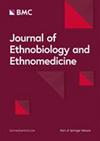Diversity of ethnomycological knowledge and mushroom foraging culture in a small nation: case of Lithuania
IF 3.7
2区 医学
Q1 BIODIVERSITY CONSERVATION
引用次数: 0
Abstract
Even in mycophilic nations, mushroom foraging and use traditions may vary from region to region, making it part of cultural diversity and a source of traditional knowledge even in modern and changing societies. The main objective of our study was to investigate mushroom foraging and use traditions in major ethno-regions of Lithuania, to record and analyse whether and how biogeographical and ethno-cultural features influence these traditions, what is their biocultural significance, and whether they persist in the face of societal and environmental change. The study conducted a survey among 106 respondents from eleven administrative units of Lithuania, representing four ethno-regions (Žemaitija, Suvalkija, Dzūkija and Aukštaitija, the latter divided into North and East). The age of the respondents ranged from 32 to 97 years (mean 70 years, median 68 years). Each respondent was asked six questions about mushroom species and mushroom foraging. The interviews were accompanied by 50 photographs of different mushroom species. The similarity between mushroom foragers' preferences in ethno-regions and the sets of mushroom species used for food and medicine was tested using cluster analysis. Clustering was carried out using Sørensen distances and the method of cluster mean linkage method. The number of mushroom species recognised per respondent was quite similar, with the lowest number of mushroom species recognised in Žemaitija and the highest in Eastern Aukštaitija. Species of no economic or other importance were not well recognised in any of the regions. The number of names applied to mushroom species varied from region to region and did not coincide with the popularity of mushrooms among mushroom pickers. The number of mushroom species used for food was also similar between regions, except for Dzūkija, which had the lowest number of species collected. Nine mushroom species were identified by respondents as medicinal mushrooms, the most popular being Amanita muscaria and Inonotus obliquus. When analysing the similarity of mushroom species collected for food and medicine, it was found that ethno-regions clustered into three distinct groups. Two groups depended on the prevailing forest types, while Žemaitija formed a separate cluster defined only by local traditions. The work represents the largest study of ethnomycological tradition in Lithuania, covering major ethno-regions. We have found that ethnomycological knowledge and tradition are not influenced by any long-term historical events, ethnicity or religion, but rather by the prevailing forest types and regional ethno-culture. Knowledge of edible mushrooms is considered to be inherited from the older generation and is conservative regarding the changes in the set of species consumed and mushroom-related gastronomy. This is also reflected in the safety of mushroom consumption, as mushroom poisoning was very rare among the respondents. Economically insignificant mushrooms are not distinguished and overlooked by traditional mushroom pickers who are not a good source of information on rare or otherwise noteworthy species. However, from a biocultural point of view, mushrooms and mushroom-related traditions remain important for linguistic diversity, traditional knowledge systems and their transmission.一个小国的人种菌学知识和蘑菇觅食文化的多样性:立陶宛的案例
即使在嗜菌国家,蘑菇的采摘和使用传统也会因地区而异,这使其成为文化多样性的一部分,也是传统知识的来源,即使在现代和不断变化的社会中也是如此。我们研究的主要目的是调查立陶宛主要民族地区的蘑菇觅食和使用传统,记录并分析生物地理和民族文化特征是否以及如何影响这些传统,它们的生物文化意义是什么,以及面对社会和环境变化,它们是否依然存在。该研究对来自立陶宛 11 个行政单位的 106 名受访者进行了调查,他们代表了四个民族地区(Žemaitija、Suvalkija、Dzūkija 和 Aukštaitija,后者分为北部和东部)。受访者的年龄从 32 岁到 97 岁不等(平均 70 岁,中位数 68 岁)。每位受访者都被问了六个关于蘑菇种类和蘑菇觅食的问题。访谈还附有 50 张不同蘑菇品种的照片。采用聚类分析法测试了民族地区蘑菇觅食者的偏好与用于食用和药用的蘑菇种类之间的相似性。聚类分析使用索伦森距离和聚类平均联系法进行。每个受访者认可的蘑菇物种数量非常相似,Žemaitija 地区认可的蘑菇物种数量最少,而东 Aukštaitija 地区认可的蘑菇物种数量最多。经济或其他方面不重要的物种在任何地区都没有得到很好的认可。蘑菇物种的名称数量因地区而异,与采菇者对蘑菇的喜爱程度也不一致。用于食用的蘑菇种类数量在各地区之间也很相似,但祖基雅地区除外,该地区采集的蘑菇种类数量最少。有九种蘑菇被受访者认定为药用蘑菇,其中最受欢迎的是鹅膏蕈(Amanita muscaria)和黑蘑菇(Inonotus obliquus)。在分析采集的食用和药用蘑菇种类的相似性时,发现民族地区分为三个不同的组别。其中两个群体取决于当时的森林类型,而Žemaitija 则形成了一个仅由当地传统界定的独立群体。这项工作是对立陶宛民族医药学传统的最大规模研究,涵盖了主要的民族地区。我们发现,民族菌学知识和传统并不受任何长期历史事件、民族或宗教的影响,而是受当时的森林类型和地区民族文化的影响。人们认为食用菌知识是从老一辈人那里继承下来的,对于食用菌种类的变化和与蘑菇有关的美食都持保守态度。这也反映在食用蘑菇的安全性上,因为受访者中很少发生蘑菇中毒事件。经济价值不高的蘑菇不会被传统采菇人区分和忽视,他们不是稀有或其他值得注意的物种的良好信息来源。不过,从生物文化的角度来看,蘑菇和与蘑菇有关的传统对于语言多样性、传统知识体系及其传承仍然非常重要。
本文章由计算机程序翻译,如有差异,请以英文原文为准。
求助全文
约1分钟内获得全文
求助全文
来源期刊

Journal of Ethnobiology and Ethnomedicine
PHARMACOLOGY & PHARMACY-
CiteScore
7.30
自引率
16.70%
发文量
66
审稿时长
>12 weeks
期刊介绍:
Journal of Ethnobiology and Ethnomedicine publishes original research focusing on cultural perceptions of nature and of human and animal health. Journal of Ethnobiology and Ethnomedicine invites research articles, reviews and commentaries concerning the investigations of the inextricable links between human societies and nature, food, and health. Specifically, the journal covers the following topics: ethnobotany, ethnomycology, ethnozoology, ethnoecology (including ethnopedology), ethnogastronomy, ethnomedicine, ethnoveterinary, as well as all related areas in environmental, nutritional, and medical anthropology.
Research focusing on the implications that the inclusion of humanistic, cultural, and social dimensions have in understanding the biological word is also welcome, as well as its potential projections in public health-centred, nutritional, and environmental policies.
 求助内容:
求助内容: 应助结果提醒方式:
应助结果提醒方式:


